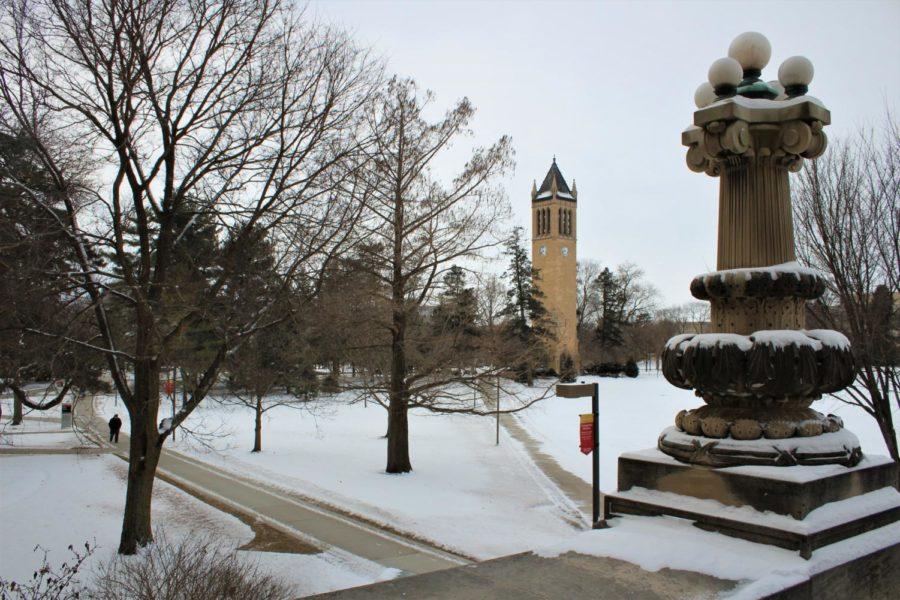Revitalization movement means heritage restoration for Myaamia
Ian Steenhoek / Iowa State Daily
Campanile Winter 2017
February 9, 2017
“Language is not a thing, it is an expression. What is it expressing? It is expressing a culture,” Daryl Baldwin said referring to his area of expertise in his lecture titled “Linking Language and Well–Being from a Myaamia Perspective.”
Daryl Baldwin, graduate from the University of Montana, is a linguist and a scholar striving to bring the people of the Myaamia (Miami) Tribe together through the resurrection of the native language.
After teaching himself the Miami language, he now serves as the founding director of The Myaamia Center and works to promote the progress of the Native community through educational preservation programming.
Baldwin’s lecture focused on the progression of the Myaamia Tribe rather than the past. While just touching on the history of the tribe, the importance was emphasized on the efforts not only he has made toward the revitalization of the culture but also efforts made nationwide.
In 1988, the linguistics and cultural revitalization process made significant progress as Myaamia descendants began to reconstruct the language.
“It’s an imperfect process,” Baldwin said about the creation of pronunciation and grammar in the spoken and written forms of Myaamia.
Issues arose in the reconstruction process as discrepancies plagued newly created rules of speech: how can you teach pronunciation when there are no more native speakers? However, this hurdle did not stop their efforts.
“We created our language and we can recreate our language,” Baldwin said. He went on to say they handled these issues by borrowing rules from closely-related languages.
The Myaamia Project in 2001, later to be named the Myaamia Center, was sponsored by Miami University in Oxford, Ohio, and focuses on educating the Myaamia community on language, culture and history.
“The goal is not only to learn but to get rid of some of things we have accumulated over the years, such as cultural shame,” Baldwin said, as many of the educational programs focus on Myaamia youth and teaching them to not be ashamed of their culture as many of the older generations were.
With revitalization efforts beginning about 30 years ago, the Myaamia community is seeing a shift in the encouragement from a young age to embrace the culture. The middle of the 20th century brought about the death of the last of the native speakers of the Miami language.
Previous generations did not pass on the language to their children as assimilation into an English-speaking world became more necessary and parents wanted to protect their children from the same racism and ridicule that plagued them growing up.
The shift in cultural acceptance came as many of the children once involved in the earlier reconstruction efforts are now becoming parents themselves. The Eewansaapita Summer Youth Educational Experience is just one way Myaamia children are able to educate themselves about their culture, but also surround themselves with other children who share in the same experiences.
Myaamiaataweenki workshops allow for Myaamia adults to either further educate themselves about their culture and language or explore a culture they were previously not as freely encouraged to participate in.
There to assist Baldwin was Haley Strass, Iowa State graduate student in counseling psychology. Being a member of the Miami Tribe of Oklahoma, Strass helped to explain her and Baldwin’s combined efforts to provide and promote education within the Native community.
Strass has been involved in revitalization programs since the age of 10, attending Miami University for her bachelor’s degree. Her contribution to the lecture focused more on the goals the revitalization movement has going forward.
The effort statement of the movement, “Reconnecting Myaamiaki to their indigenous knowledge system” binds the community together under a definable goal. The progress of the movement is measured on how well the Myaamia people felt toward their four main goals: well-being, identity, academic attainment and trial engagement, connection and commitment.
Strass explained the tribe’s different definition of the status of “ well-being” as “simply living well.”
Baldwin and Strass have spent years of their lives learning the Myaamia language and furthering their knowledge of the tribal heritage. Generations may separate their experiences, but the revitalization movement unifies them under a common goal.
“Our effort statement doesn’t even list language. It’s not even a goal anymore; it’s an outcome,” Baldwin said.
He acknowledges the movement’s transition from a complex process of language reconstruction into a heritage restoration that will leave a lasting impact on a whole of the Myaamia community.







